Chapter 3
Basic Digital Sculpting
Digital sculpting refers to a brush-based approach to creating three-dimensional models on a computer. ZBrush revolutionized the computer game and entertainment industry as well as digital art by introducing its unique digital sculpting technology about 12 years ago. Since then, the older methods of pushing and pulling individual polygon vertices and faces have largely been replaced with digital sculpting. Digital sculpting in ZBrush offers a much more intuitive and artistic way to create models. This is what has made ZBrush so attractive to artists who are less interested in the technical aspects of computer software and more concerned with creating great artwork.
In this chapter, you’ll be introduced to the basics of digital sculpting in ZBrush. We will cover the following topics:
- Understanding digital clay
- Loading and saving ZBrush projects
- Using sculpting brushes
- Working with dynamic levels of subdivision
- Using Dynamesh to create a sculpting topology
- Applying masks to your surface
- Using parametric 3D objects
- Using deformations
- Moving parts using Transpose
Digital Clay
Digital clay is a term affectionately applied to a polygon mesh in ZBrush. This type of mesh is a surface made up of connected polygon faces. Each face shares vertices and edges with neighboring polygon faces (see Figure 3-1). ZBrush allows the polygon faces to be made up of three- or four-sided polygons. These meshes are called digital clay because of the way in which they are shaped by the sculpting brushes. Shaping polygon meshes with the brushes feels so intuitive that it’s a lot like working with clay.
Figure 3-1: Digital clay is a polygon mesh made up of three- or four-sided polygons.
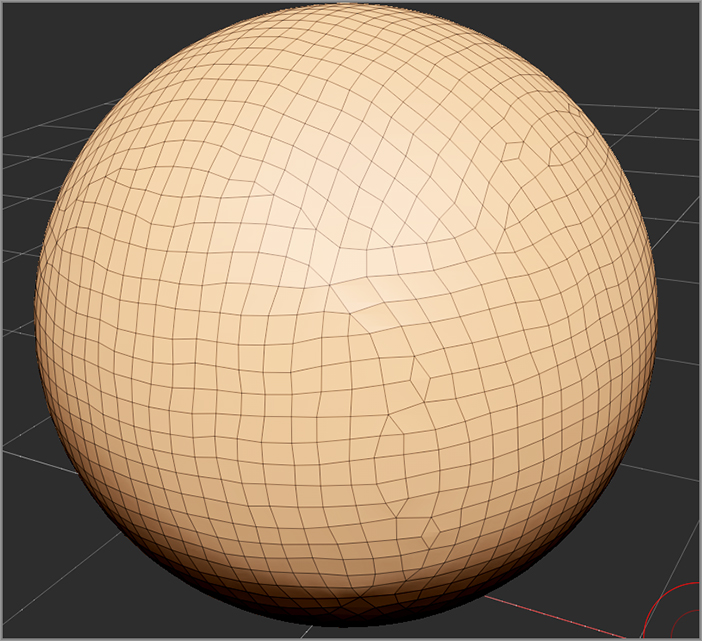
Many terms are used interchangeably in ZBrush. Digital clay, polygon mesh, 3D model, and 3D tool all mean pretty much the same thing. You create your models by shaping the surface on the canvas using the sculpting brushes. In order to use the brushes, you must activate Edit mode on the top shelf. Think of Edit mode as Sculpt mode.
The digital clay you use to start your model can be generated a number of different ways. You can use one of the 3D primitive presets or one of the premade models that comes with ZBrush, or you can import a polygon model created in another software package such as modo, Autodesk® 3ds Max®, Cinema 4D, or Autodesk® Maya®. In addition to working with conventional meshes, ZBrush has a number of unique tools that allow you to generate digital clay that can then be sculpted into any shape you wish.
In this chapter, you’ll learn the basics by starting with a simple lump of digital clay that you’ll shape with the sculpting brushes. As you go, you’ll learn new tools and techniques, and in later chapters you’ll learn even more ways to start and sculpt a model.
Using the Sculpting Brushes to Create a Dragon’s Head
The easiest way to learn your way around ZBrush is to start with a clearly defined goal. In this case, I’ve chosen a dragon’s head as the subject because, well, everyone loves dragons; they are simple, familiar, culturally universal, and fun.
Regardless of how you generate your initial mesh, you will almost always use the sculpting brushes to shape your lump into something more exciting. Once you understand how to use the brushes, all the other elements of the ZBrush interface will make sense. The following demonstrates the fastest and easiest way to start sculpting.
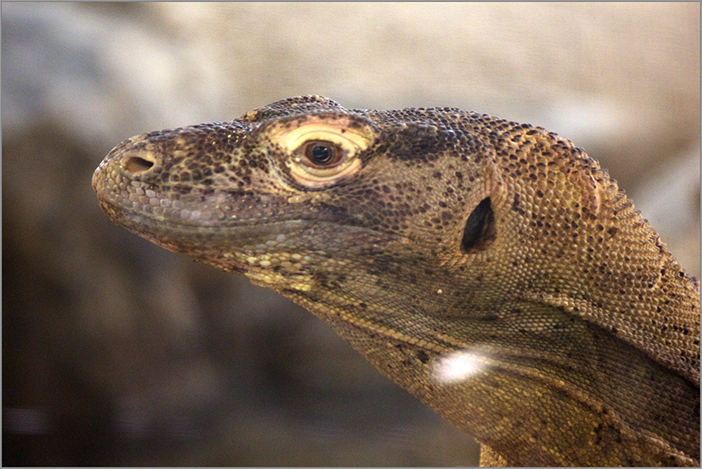
Light Box is a quick and easy browsing interface used to load projects, digital sculptures, textures, and other resources onto the ZBrush canvas. If you are not familiar with using Light Box, consult Chapter 2.
Figure 3-2: Choose the DefaultSphere.ZPR project from the Project section of Light Box.
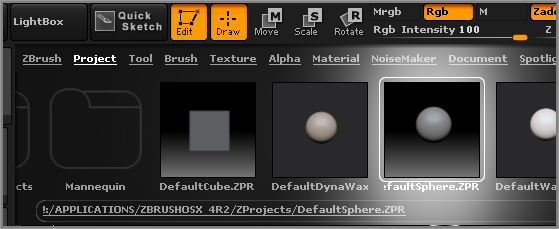
The DefaultSphere that appears on the canvas is known in ZBrush terminology as the PolySphere. What is a PolySphere? It is a rounded cube and not a typical spherical mesh. A typical spherical mesh has poles—areas on the surface where a large number of triangular faces share a single vertex. These poles can cause pinching and distortion in your sculpt. The advantage of the PolySphere is that it does not have poles, so it is much easier to work with. I use the PolySphere all the time for this reason (see Figure 3-3).
Figure 3-3: The PolySphere on the left is easier to sculpt because it does not have poles like the Sphere3D on the right.
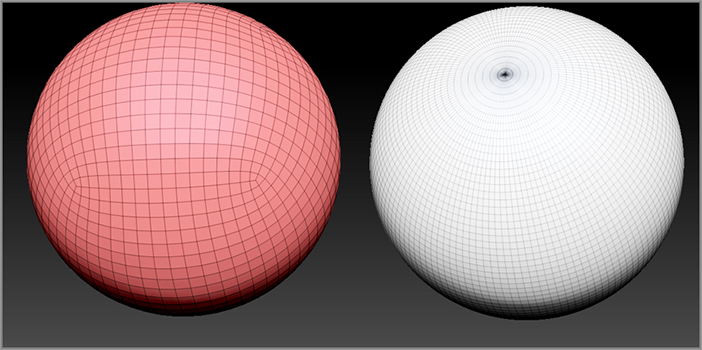
If you’re not sure whether you’re using a PolySphere or a typical spherical mesh, click the PolyF button on the right shelf, and you’ll see the wireframe display on the mesh. The PolySphere should look like the sphere on the left in Figure 3-3 and not the sphere on the right.
You can turn symmetry on or off by pressing the X hotkey. For now let’s leave it on. Later in this chapter you’ll learn about more advanced symmetry options. If you run into a situation where symmetry has been activated but you see only a single dot, you may need to rotate the model until you’re facing the correct axis, at which point the two dots should appear. Basic navigation is covered in Chapter 2, “Understanding the ZBrush Interface.”
When I start a sculpt, I like to use the BasicMaterial2 shader, which you will find in the material fly-out library on the left shelf. Simply open the library by clicking the Material icon, and choose BasicMaterial2. How to use the material library is covered in Chapter 2. The BasicMaterial2 shader is not as exciting as some of the others, but it gives you the best sense of the shape of your sculpt as you work. It’s good to change materials occasionally while you work.
Figure 3-4: Use the Move brush to start shaping the PolySphere into something that looks like a dragon’s head.
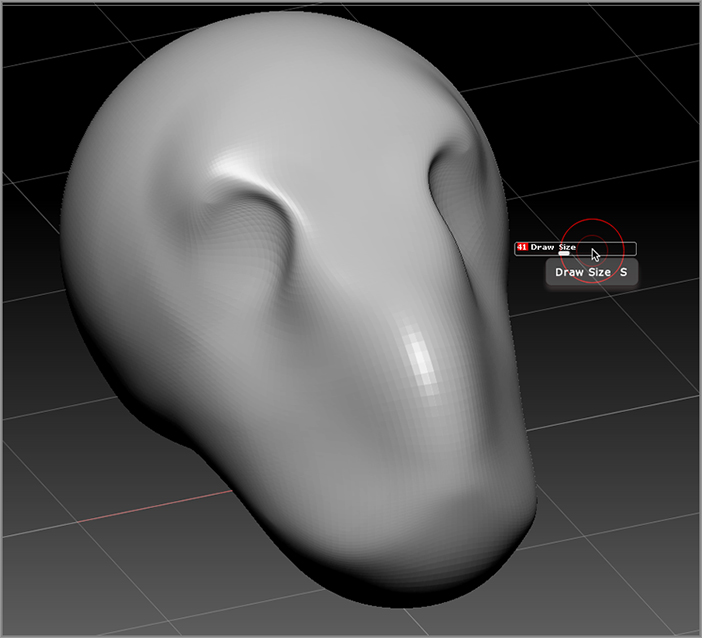
- Increase the Z intensity if you want to have a stronger influence on the surface. Sometimes I like to have a strong intensity with a small brush size for precise changes and a low Z intensity with a large brush size to make more general changes.
- Hold the Alt key while dragging on the surface to move the surface along the surface normal (surface normals are defined in Chapter 1, “Digital Art Basics”). Drag left while holding the Alt key to push in; drag right while holding the Alt key to push out.
- Change the Focal Shift slider to adjust the brush falloff. A low focal shift will give the brush a hard edge; a high focal shift will create a smooth falloff.
- Other variations of the Move brush are available in both the sculpting brush library and the Brush/Move section of Light Box. These variations can create some really interesting effects.
The Move Elastic brush works best on meshes with 24,000 polygons or less. If you use it on a dense mesh (meaning a mesh with a lot of polygons), it will slow down performance significantly. This is because ZBrush is updating the model as you work, which takes some calculations. As you work through the examples in this book, you’ll learn about other Move brush variations, such as the Move Topological and Move Parts brushes. Switching brushes while working is a great way to explore new ideas and forms.
Figure 3-5: Try using the Move Elastic brush to shape the head; compare how the surface reacts to the Move Elastic brush versus the Move brush.
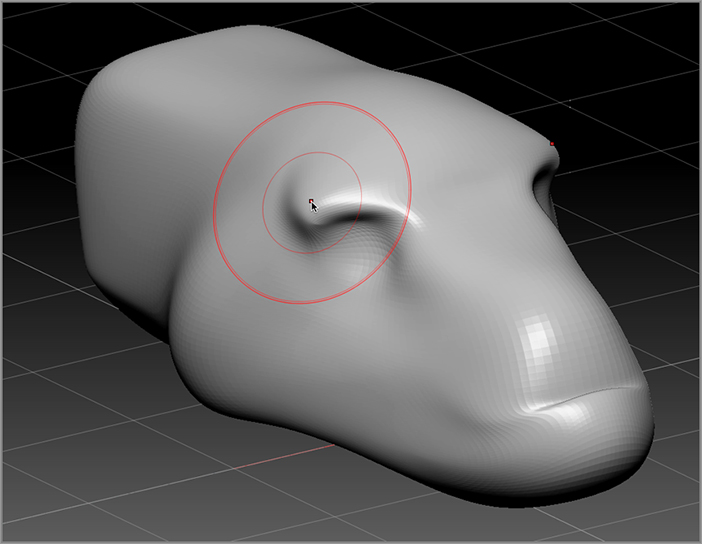
Figure 3-6: A basic dragon’s head is shaped using the Move, Move Elastic, and Nudge brushes.
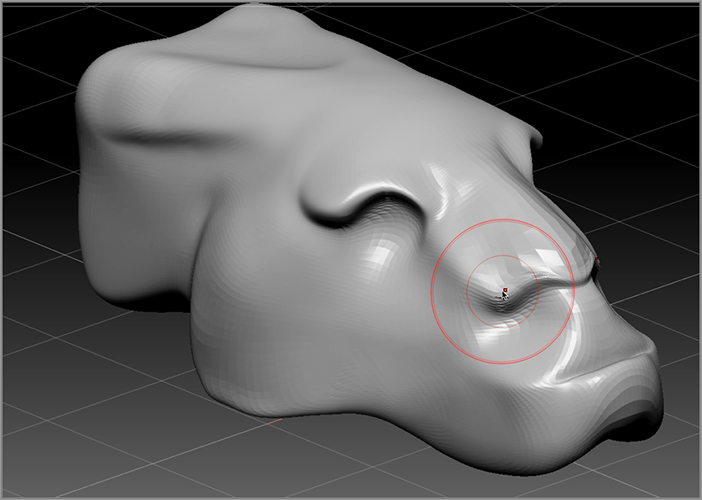
Using the Smooth Brush
As you shape your model, you’ll no doubt get some stretching in the surface. One way to deal with this is to use the Smooth brush. Hold down the Shift key and drag over the model. The Smooth brush evens out the surface and reduces the stretching.
The shape of the surface seems to shrink and melt away as you brush over it while holding down the Shift key. The Smooth brush averages the distance between the vertices on the surface. If the changes are too extreme, you can lower the Z intensity of the Smooth brush.
Figure 3-7: Alternate using the Move and Smooth brushes while creating the basic shape of the dragon’s head.
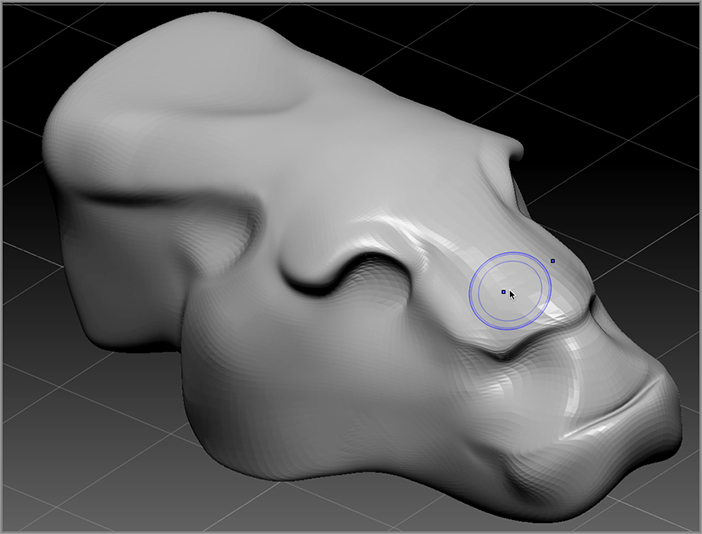
- The Z intensity of the Smooth brush is independent of the current brush, meaning that the value changes when you switch to the Smooth brush. ZBrush remembers the Z intensity of the Smooth brush even when you release the Shift key and switch to another brush. This is also true of the Focal Shift setting but not Draw Size.
- A high Z intensity, such as the default setting of 100, can quickly obliterate details sculpted into the mesh. It’s good practice to set the Z intensity of the Smooth brush to somewhere between 20 and 40 while working.
- A number of other smoothing brushes are available in the brush fly-out library and in the Brush section of Light Box. If you choose one of these brushes, you’ll get a message letting you know that the chosen smoothing brush will be active only while you are holding down the Shift key. The other smoothing brushes have unique properties that will make more sense once you’ve learned more about ZBrush.
- The Brush palette contains a set of controls that are dedicated to the Smooth brush. These are found toward the bottom in the Smooth Brush Modifiers subpalette, as shown in the following image. This palette will be explained in more detail in Chapter 7, “Advanced Brush Techniques.” For now it is useful to know that the Alt Brush Size slider adjusts the size of the Smooth brush. This value is a multiplier for the Draw Size setting. When you set Alt Brush Size to 2, every time you hold down the Shift key, the draw size of the Smooth brush will be twice the draw size of the current brush. A setting of 10 will make the Smooth brush 10 times the current brush size.

Defining Forms with the Standard and Clay Brushes
Once you have the basic dragon’s head form established, you can start building basic detail using the standard band clay sculpting brushes. Of course, you can use the sculpting brushes in any order you wish and switch between the brushes at any time. I find it’s easier to introduce the sculpting process to new students by working with just a few brushes at a time. Focus on large bony forms for now; at this point you should not worry about little details like scales and wrinkles.
The Standard brush causes the points of the mesh to be pushed outward based on an average of their normal direction. If you hold the Alt key while dragging across the surface, the brush is reversed so that the mesh gets pushed inward.
The Clay brush also causes the surface to be raised, but it generally fills in the recessed areas of the surface first, making the brush feel as though you’re pressing clay into the surface. It’s important to understand that none of the sculpting brushes actually add or remove points from the surface; they just move the existing points around based on their own specific algorithms.
Just like with the other brushes, the Z intensity increases the amount of influence the brush has on the surface, and the Focal Shift adjusts the falloff.
Figure 3-8: Use the Standard and Clay brushes to further define the forms of the head.
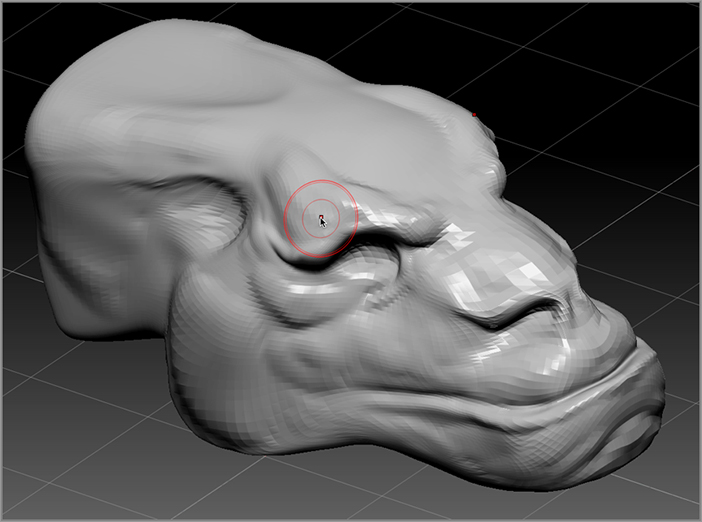
- Sometimes the Clay brush can cause problems when you’re working on thin surfaces such as ears. While the part of the surface that is facing you may appear fine, the reverse side may become stretched, as shown in the following image below. To fix this, open the Brush palette, click the Auto Masking button, and activate the Backface Mask button. This is off by default simply because it may slow down performance on high-density meshes.
- There are many variations of the Clay brush. Try using the Clay Tubes and Clay Buildup brushes, and see how they behave when working on your model.
- Just like the Standard brush, the Clay brush will dig into the surface when you hold the Alt key.
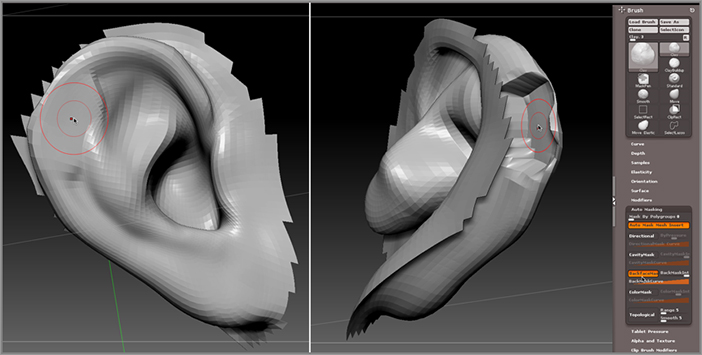
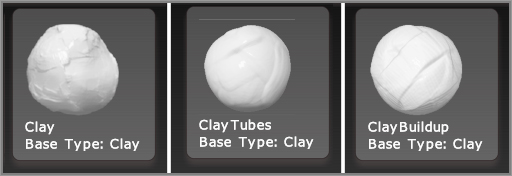
Working with Dynamic Levels of Subdivision
You may have seen many highly detailed ZBrush models on the Internet or in movies or video games. How do artists get all this detail into their ZBrush model? It’s done by subdividing the mesh, which means that the number of polygons that make up the surface is multiplied, giving you more polygons to work with so the brushes can easily add more detail.
The great thing about ZBrush is that when you add more polygons to the surface by subdividing, you can easily go back to a lower number of polygons. In fact, you can go back and forth between a version of the model that has few polygons and less detail and a version of the model that has many polygons and a lot of detail. You can do this as often as you like while you shape your model. So at lower levels of subdivision (known as an SDiv level) you can shape the overall form, kind of like what you’ve already done with your dragon’s head. Then you can subdivide, add more details like the nostrils and eye sockets, then subdivide a few more times to add scales and curling lips, and so on until the model is made up of millions of polygons and loads of realistic detail. But you can, at any time, go back to the lower SDiv level, make changes to the overall form, and ZBrush will remember and retain all of those crazy details, so that when you switch back to a high SDiv level, you still have your scales and wrinkles and curling dragon lips. This gives you an amazing amount of control as an artist, and it’s something you really can’t do in traditional media such as clay.
In this next section, we’ll take the dragon’s head you have been working with and add a few levels of subdivision to show how to use this to your advantage.
The default PolySphere you used to start your model already has three SDiv levels, and you can easily add even more.
Figure 3-9: Low subdivision levels have fewer polygons and less detail (left image). Add a fourth level of subdivision to increase the number of polygons available for sculpting (right image).

Figure 3-10: You can switch between higher and lower subdivision levels as you work to sculpt detail or make major changes to the form.

- To add a level of subdivision, you must have the slider set to the highest SDiv level; otherwise, you’ll get a warning message.
- You can delete the levels of subdivision by clicking the Delete Lower or Delete Higher Levels Of Subdivision button. Doing this will automatically renumber the SDiv levels, so if you are at level 3 and you delete lower levels of subdivision, what was level 3 now becomes level 1.
- When you subdivide the model, the surface will be smoothed automatically. If you want to keep the hard-edge look of the model when you subdivide, turn off the Smt button next to the Divide button in the Geometry subpalette.
- You can add a lower level of subdivision by setting the SDiv slider to the lowest level and clicking the Reconstruct Lower Subdivision button found in the Geometry subpalette of the Tool palette. Use this with caution because it can sometimes affect detail at the highest SDiv level. When in doubt, save the file before clicking this button! In some cases this won’t work. If the mesh has triangles, ZBrush will not be able to add a lower level of subdivision.
- You can subdivide sections of a mesh if parts become overly stretched. To do this, move the SDiv slider to the lowest SDiv level and click the Equalize Surface button in the Geometry subpalette. You can also explicitly subdivide a section of the surface using masking. This will be discussed later in the chapter in the section on masks.
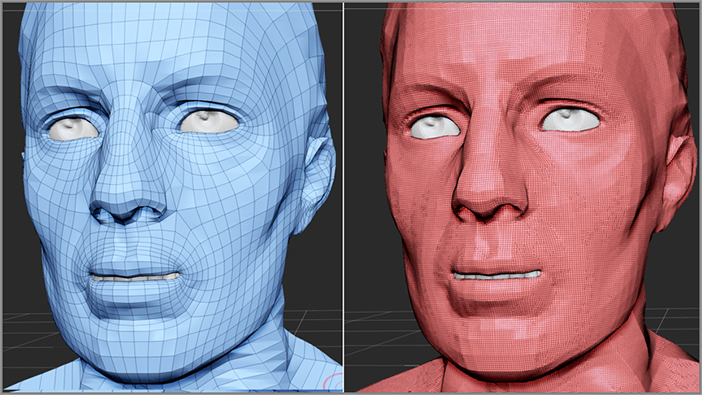
Creating a Sculpting Topology with Dynamesh
As you work over the surface with the sculpting brushes, the surface may appear stretched as the polygons of the mesh are pulled. This happens especially when you pull out the mouth of a dragon or try to make ears or horns. The Smooth brush can help alleviate this, but it can only take you so far, and too much smoothing results in kind of an amorphous blob. Subdividing the model also helps eliminate the stretching, but as you sculpt against the “grain” of the polygon, the surface still can look stretched unless you work on a mesh that has millions of polygons.
To eliminate these types of problems Pixologic has introduced a new technology known as Dynamesh. Dynamesh creates a sculpting-friendly topology dynamically as you work whenever you need it. Dynamesh is a special mode that, when activated, rebuilds the topology of your mesh to make it easier to sculpt. Let’s try it out on the dragon’s head you have been working on.
Using Dynamesh on the Dragon’s Head Model
Figure 3-11: Dynamesh instantly retopologizes the surface of the model so it is easier to sculpt. The result is a surface made up of evenly distributed squares and triangles.

If you feel like you don’t have enough polygons (or maybe too many), you can easily change the number dynamically (hence the term Dynamesh) by changing the Resolution slider below the Dynamesh button. The surface updates automatically. Lower values mean fewer and larger polygons.
Figure 3-12: Pull some horns out of the head using the Move brush. Hold down the Ctrl key and drag on the canvas to instantly retopologize the surface, eliminating stretching.
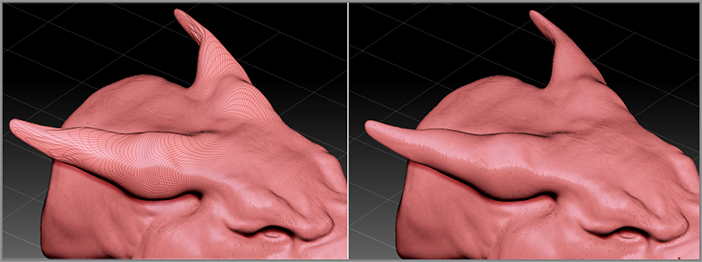
Figure 3-13 shows the process I went through in shaping my dragon’s head. Throughout this process I’m still experimenting with ideas, adjusting the anatomy and the personality of the dragon as I work. You’ll find that this workflow turns ZBrush into a great tool for sketching out ideas.
Figure 3-13: Using Dynamesh to update the topology of the surface as you work, you can easily pull clay out from the geometry of the head.
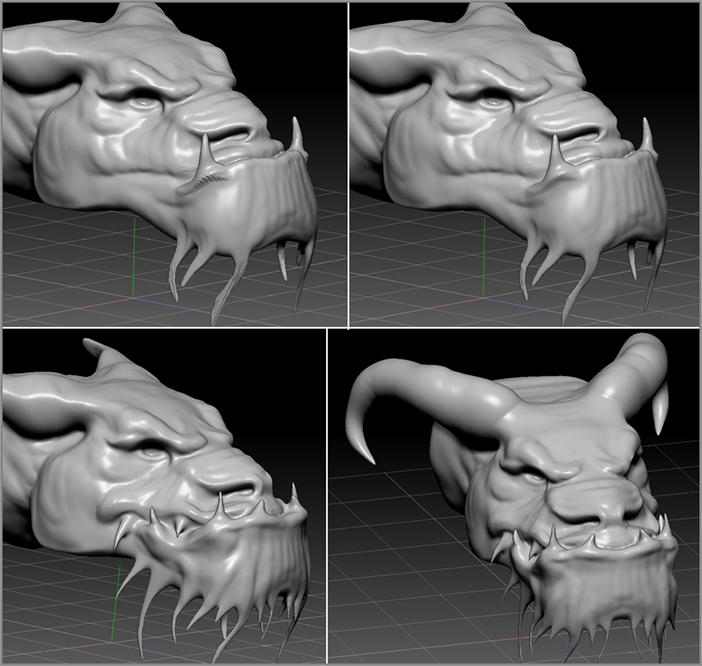
Editing Your Design
Using Dynamesh, you can feel free to experiment while sculpting. You’re never stuck with what you make, and you can always easily make radical changes and then remove them at will if you change your mind. For example, I’ve decided that the horns on my dragon make him look too much like a ram. I want to get rid of them without starting over. Using the Dynamesh workflow, I can simply squish the horns back into the head and try something different.
Figure 3-14: The Resolution slider is found below the Dynamesh button in the Geometry subpalette of the Tool palette.

To make this easier you can use the Move Topological brush to push the horns back into the head. The Move Topological brush samples the surface as you work to determine which parts of the mesh are connected. You can use this brush to move the horns close to the head without affecting the head itself. The brush may feel a little sticky because the mesh is fairly dense. Generally, it’s best to use the brush on a lower-density mesh.
Currently, my mesh has more than 150,000 points, but I deleted the lower levels of subdivision. So how can you create a mesh that’s a little easier to work with? You can change the resolution of Dynamesh so there are fewer polygons to work with, making it easier to edit the overall form:
How did I come up with a setting of 64? I came to this value through experimentation. If the resolution you choose is not low or high enough for what you want, you can undo (Ctrl+Z), set a new value, and then try again until you get a resolution you like. The scale of the object will affect the resolution. A very small object requires a higher-resolution setting to get a decent number of polygons; a very large object can become extremely dense when you “dynamesh” at even a low-resolution setting.
Figure 3-15: Use the Move Topological and Inflate brushes to move the horns back toward the surface. Activate Dynamesh again, and the horns are fused to the surface. With a little cleanup, the horns are completely gone.

I decided to get rid of the teeth and the tendrils using the same techniques (see Figure 3-16). You can continually model and shape with Dynamesh as you explore ideas.
Figure 3-16: The tendrils on the chin have been removed by simply pushing them back into the surface and re-dynameshing the surface.
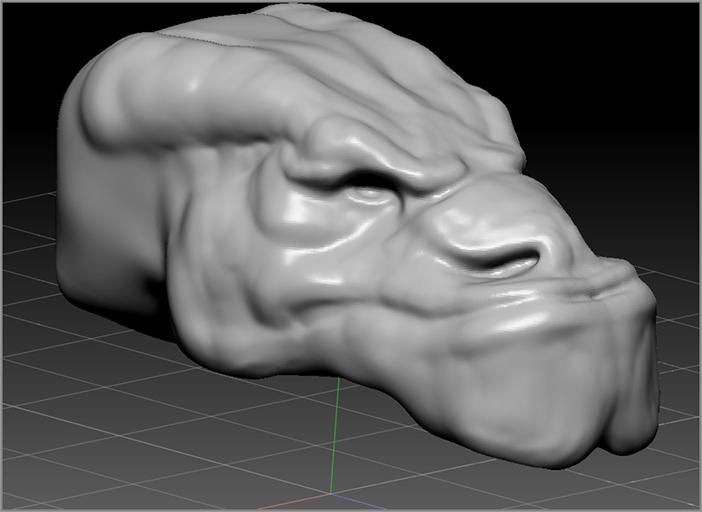
Refining the Surface with Polish Brushes
As you sculpt your digital clay, you may notice that the shape can become quite lumpy. You can reduce the lumpiness of the form as well as bring definition to the planes of the dragon’s head using the polish brushes.
Figure 3-17: Use the hPolish brush to refine the forms of the dragon’s head.
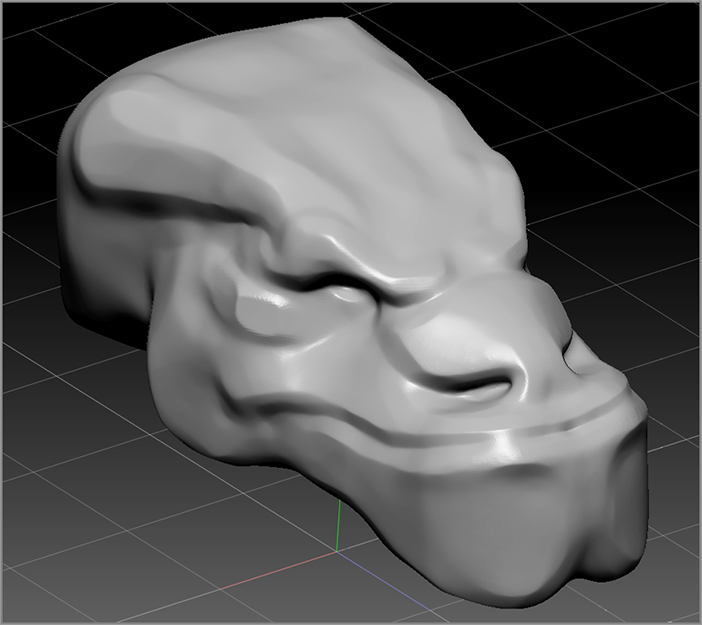
- Just as with the other sculpting brushes I tend to smooth as I work by alternating holding and releasing the Shift key.
- The hPolish brush can be used to create sharp angles when it is used to polish adjacent forms.
- Several variations of the Polish brush are available in the brush library, including nPolish and sPolish, and even more in the Brush section of Light Box.
- The hPolish brush presses down the surface; if you want to use the brush to build out the surface, hold down the Alt key.
- The Trim Dynamic brush can also be used to refine the surface. It is similar to the hPolish brush but with some subtle differences. I use both while I am working. The Trim Dynamic brush is good at flattening sharp edges.
- If you activate the Polish option to the right of the Dynamesh button in the Geometry subpalette of the Tool palette, then every time you re-dynamesh the surface, it will add an overall polish to the surface. This can eliminate lumps as well as accentuate the contours of your design. It also keeps the dynameshed surface from becoming too “soft.”
Masking
Masking protects a specified part of the mesh as you make changes. Masks give you more precise control over the mesh, and there are a number of ways to create masks. Masks are created using the Masking Pen brush. This brush is activated when you hold down the Ctrl key while the Draw button is active on the top shelf.
Using masks you can increase the level of precision you have when using the sculpting brushes. Also, a number of processes in ZBrush require that parts of the surface be masked in order to work properly. Let’s start by discussing the basics of creating masks.
- Hold Shift to activate smoothing brushes.
- Hold Ctrl to activate masking function.
- Hold the Alt button to reverse the brush; this creates the opposite action in the brush. If the brush normally pushes out, then it will push in when you hold the Alt key. If the brush normally smoothes, then the Alt key will make it sharpen, and if the brush normally masks, holding Alt will make it unmask.
Mask Controls
In this exercise you’ll use masking to control which parts of the dragon’s head model can be edited with the brushes.
Figure 3-18: Open the Material library on the left shelf and select the SkinShade4 material.
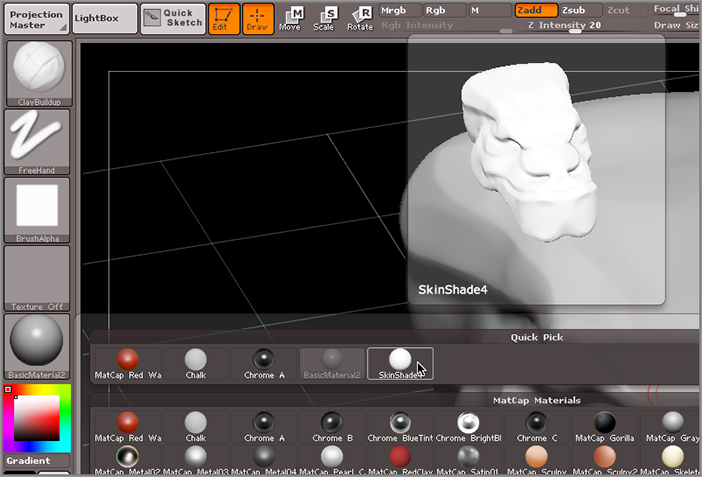
Figure 3-19: The mask on the lower lip of the dragon protects the surface from changes made with the sculpting brush.
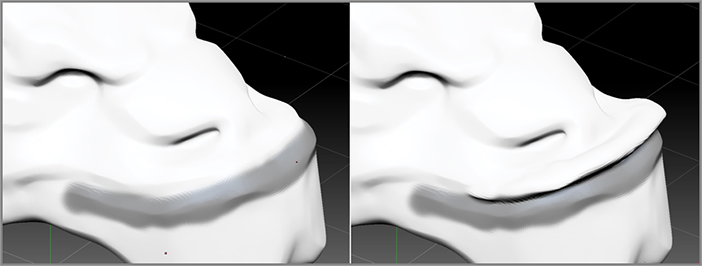
When you press and hold the Ctrl key while the Draw button is on in the top shelf, you activate the MaskPen brush. As you hold down the Ctrl key, note that the brush icon on the left shelf displays the MaskPen brush (see Figure 3-20).
Figure 3-20: While you hold down the Ctrl key, the brush switches to the MaskPen brush.

Of course, the changes I just made on the surface are not what I want at all; in fact, I want the opposite. I want to pull out the lip to make room for some giant teeth jutting out of the lower jaw. So I need to undo the last few strokes, invert the mask, and then edit the lip while the rest of the head is masked.
Figure 3-21: The mask is inverted (left image); then the edges of the mask are blurred (right image).
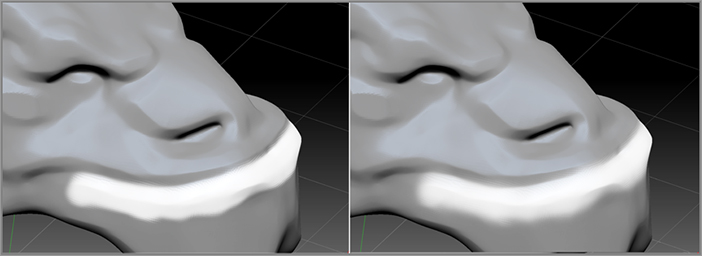
Figure 3-22 shows how I used the Move, Inflate, Smooth, and hPolish brushes to form an exaggerated underbite in the dragon.
Figure 3-22: The Move, Inflate, Smooth, and hPolish brushes are used to pull out the lower lip of the dragon.

Editing the Mask
Masks are useful and extremely flexible. You can edit the mask using the masking brushes in order to precisely isolate areas for further sculpting, all while protecting the areas you don’t want the brushes to affect. In this section, you’ll use more masking features to edit the mask painted on the dragon’s lip.
The big problem with the way the lip looks on my dragon is that it has too much of an overhang. I’m going to use the mask pen to expand the current mask and then use the ClayBuildup brush to create flesh below the lip so that it looks like the lip is stretched over large teeth coming out of the jaw. Here’s how you can accomplish the same thing on your model:
At this point the surface is getting stretched, so you can dynamesh the surface to remove the stretching. To do this you need to first clear the mask and then dynamesh. Both actions use the Ctrl+drag gesture.
Figure 3-23: The MaskPen brush is used as an eraser to expand the mask (upper left). The ClayBuildup brush is used to fill in the area below the lip (upper right). The unmasked portion is refined using the Smooth and hPolish brushes (lower left). The surface is unmasked and dynameshed to remove stretching.
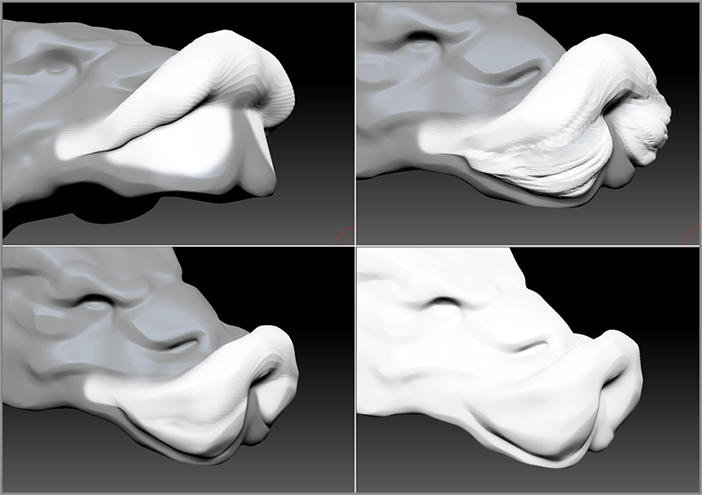
By using similar techniques you can continue to shape the dragon’s head to get it ready for adding teeth and eyeballs. Figure 3-24 shows some of the steps I used to refine the surface. In addition to using the Standard, Clay Tubes, Smooth, Move, and hPolish brushes, I used the DamStandard brush (found in the brush library when you press the D key and then the S key) to create fine lines. Try this brush to start sketching lines on the surface to help separate the features. You’ll find this brush absolutely indispensible for sculpting. I also frequently re-dynamesh the surface with the Polish option activated in the Geometry palette; this keeps the surface smooth and the edges refined. Make sure you save your project if you come up with something you like!
Figure 3-24: Using the MaskPen, Standard, Smooth, Inflate, Move, DamStandard, and hPolish brushes, the features are shaped and refined. Dynamesh is applied with the Polish feature enabled to keep the surface smooth and edges sharp.
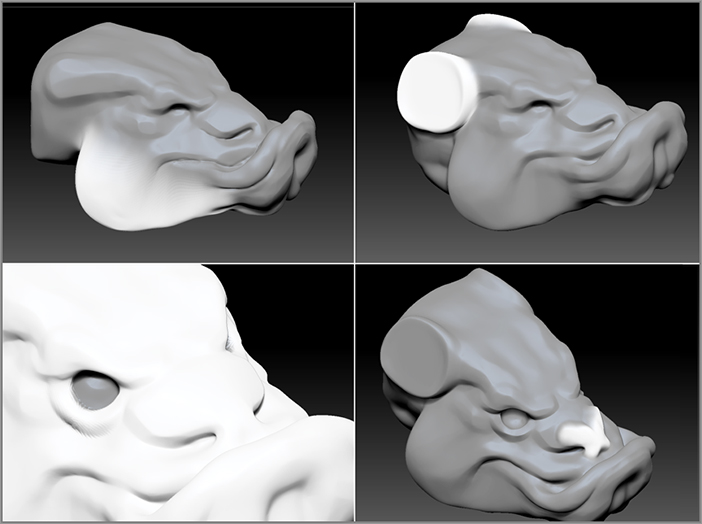
- ViewMask (hotkey = Ctrl+H) enables the visibility of the mask—the dark area on the surface. If this button is off, the mask will not be visible, but it will still prevent changes from being made to the masked area of the surface. Sometimes the dark area of the mask can be distracting while you work on the surface, so ZBrush gives you the option of turning mask visibility off. If you ever encounter a situation in which it seems as if a sculpting brush is not working properly, double-check to see if the ViewMask button is off. It may be that you have accidentally applied a mask that you can’t see.
- Inverse (hotkey = Ctrl+I) swaps the masked and unmasked parts of the surface so that the masked parts become unmasked and the unmasked parts become masked. You can also invert the mask by holding the Ctrl key and clicking a blank part of the canvas.
- Clear (hotkey = Ctrl+Shift+A) removes all masks from the surface. You can also clear the mask by holding down the Ctrl key while dragging on a blank part of the canvas. When you release the brush, all masks will be cleared.
- MaskAll (hotkey = Ctrl+A) applies a mask to the whole surface. You can also hold down the Ctrl key and click a blank part of the canvas to mask everything, provided nothing is masked already.
- BlurMask blurs the edges of the mask. The mask is still present but not as intense along the blurred edges. Another way to blur the mask is to Ctrl+tap on the masked area.
- SharpenMask sharpens the edges of the mask, making them more defined. Another way to sharpen the mask is to Ctrl+Alt+tap on the masked area.
- Hold the Ctrl+Alt keys together and paint on the surface to erase part of the mask.
- Toward the bottom of the Masking subpalette you’ll see a slider labeled Intens, as shown in the following image. This controls the intensity of the mask. The value of this slider is applied to the next mask painted on the surface; it does not affect any masks currently applied to the surface. If you set this to 50, the next mask you create will be at half the normal strength. This means that the surface will still be affected by changes you make with the sculpting brushes but only at half strength.
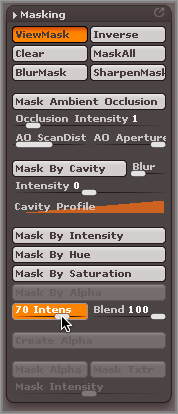
- There are many advanced masking features in the Masking subpalette, including Mask Ambient Occlusion and Mask By Cavity. These features will be covered in the sections on advanced sculpting techniques later in this book.
Mask Pen Stroke Types
The MaskPen brush can use all of the stroke types that a regular sculpting brush uses and a few extra (Rectangle, Circle, Curve, and Lasso). To change the MaskPen brush’s stroke type, hold down the Ctrl key, and then open the stroke type fly-out library and click one of the stroke type icons (see Figure 3-25).
Figure 3-25: The MaskPen brush can use the same stroke types that are available for sculpting brushes plus a few special stroke types.
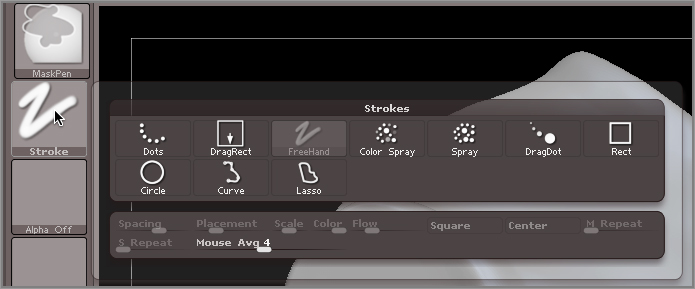
- You can select an alpha texture from the alpha fly-out library to change the shape of the mask based on a 2D image. The following image shows how the Star alpha has been applied to a mask brush.

- When you choose the Rect stroke type for the masking brush, you can then use the MaskPen brush to define a rectangular-shaped area to be masked. As you hold the brush down and drag, you can set the size of the masked area. The center of the mask is indicated by a white plus sign.
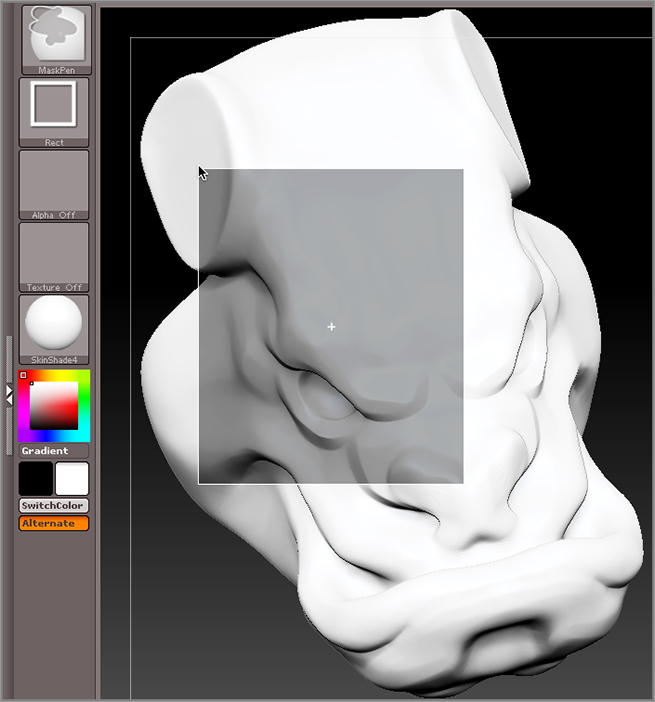
- Try not to confuse the Rect stroke type with the DragRect stroke type; they sound very similar but they behave very differently.
- If you want to reposition the rectangular mask (Rect stroke type) while using the Rect stroke type, let go of the Ctrl key and hold down the spacebar. Once your mask is in position, release pressure from the tablet to apply the mask.
- At the bottom of the stroke type fly-out library are two options: Square and Center. These buttons are shown in the following image. These options apply to the Rect and Circle stroke types. When the Square option is enabled, the masked area is always a perfect square. When the Center option is enabled, the center of the masked area is determined by wherever you initially click on the canvas. As you continue to drag, the mask is sized relative to the center. When Center is off, dragging out a corner of the rectangular area creates the mask.
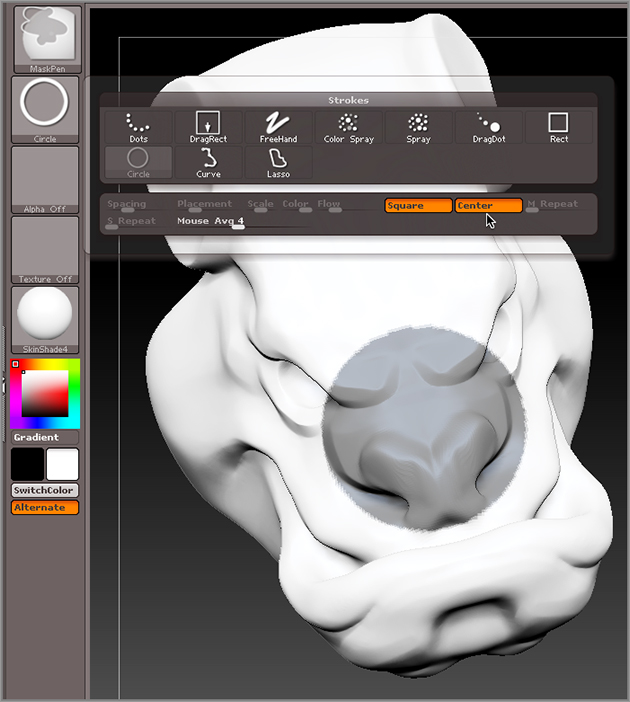
- A number of masking brush presets already have some of these features enabled. These are the MaskCircle, MaskCurve, MaskCurvePen, MaskLasso, MaskPen, and MaskRect brush presets. These are shown in the following image. To choose one of these presets you can hold the Ctrl key and open the brush fly-out library on the left shelf. When you switch to a masking pen, it is mapped to the Ctrl key.
- If you create a mask on a side of an object, the mask goes all the way through the surface and masks the opposite side as well.
- The Circle stroke type behaves just like the Rect stroke type except that the selected area is an oval and not a rectangle. If you activate the Square option in the modifiers, the masked area will always be a perfect circle.
- The Lasso stroke type lets you define a free-form area for the mask by drawing on the canvas while holding down the Ctrl key.
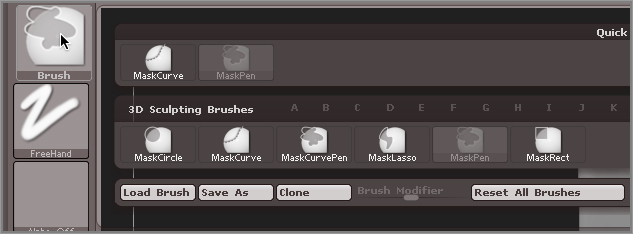
- The MaskCurvePen is a more advanced stroke type that will be discussed in Chapter 5, “ShadowBox and Clip Brushes.”
Masking is a big part of working with ZBrush. Before you move on to the next section, make sure you spend some time practicing. Open the DefaultSphere.ZPR project in Light Box and experiment with using masks and brushes on a simple surface.
Insert Brushes
The MeshInsert brush allows you to add a presculpted mesh to your model with a brush stroke. It’s a great way to add eyes, ears, teeth, and anything else you’d like to add to a surface. In this section, you’ll use the brush to add eyes to the dragon.
To use this brush successfully, you’ll need to understand the masking techniques of the previous section. You’ll also be introduced to the Transpose brush and learn a new way to generate digital clay.
Using the InsertSphere Brush to Add Eyes
There are a wide variety of ways to add eyes to a creature or character in ZBrush. In this section, you’ll use the InsertSphere brush to add two simple spheres to the dragon’s head.
Figure 3-26: Select the InsertSphere brush from the brush library (upper left). Drag inside the eye socket to insert the sphere, and continue dragging to size (upper right). The model is automatically masked when you release the InsertSphere brush (lower left). After the sphere is inserted, it is fused with the rest of the surface using Dynamesh.

Figure 3-27: The sculpting and masking brushes are used to create the eyelid around the inserted eye.
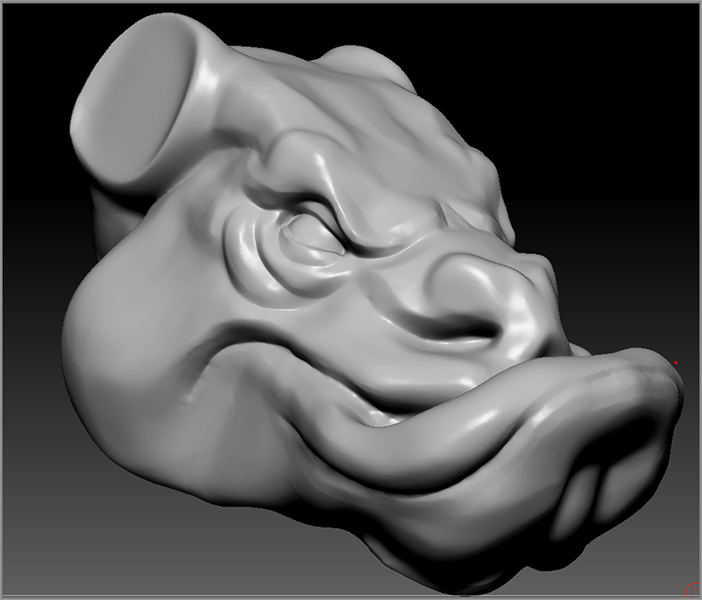
This time I increased the Resolution slider under the Dynamesh button in the Geometry subpalette of the Tool palette to 256. This allowed me to retain more of the sculpted eyelid detail each time I activated Dynamesh.
The real power of the InsertSphere brush is that you can use it to insert your own custom mesh objects into a surface. You can customize the InsertSphere brush so that you can use it to add lips, even a whole robot arm to any model you create. This is true for the insertHead, insertCube, and many of the other insert brush types. But keep in mind that these brushes work best while your model is in Dynamesh mode.
In the next section you’ll see how you can use one of the parametric 3D primitives to create a nice sharp tooth and then see how you can use the insert brush to add the tooth to the model.
Creating Teeth Using Parametric 3D Objects
In this section you’ll create a tooth using a parametric 3D object. The 3D parametric objects are all contained in the ZBrush tool library. They are called parametric because you shape them using numerical controls and not the sculpting brushes. Once you have a shape you like, you can convert it into a regular 3D mesh that can then be sculpted with the brushes. It sounds a little confusing at first, but we’ll start simply with a basic tooth, which should make the idea clear.
Figure 3-28: Select the Cone3D object from the tool library.
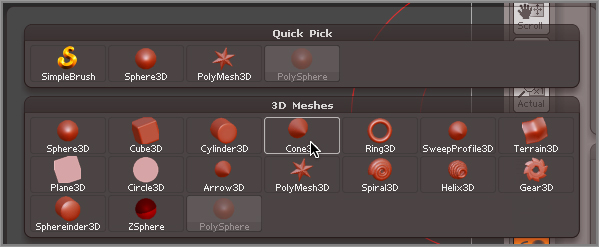
The dragon’s head will disappear, and you’ll see a cone on the canvas. Don’t worry; the dragon is just fine. By selecting a different tool from the Tool library, you’ve essentially moved the dragon off your virtual sculpting stand and replaced it with an instance of the cone. You can switch back at any time by opening the tool library and selecting the dragon’s head model. Most likely the model is still named PolySphere. We’ll talk more about organizing and renaming tools in Chapter 4, “Polymesh Editing.” For now let’s keep focused on the basics.
Figure 3-29: ZBrush displays a warning when you try to sculpt the cone.

Using these sliders, you can decide how many divisions you want in the cone and whether the bottom is closed or has a hole through it.
The result should be a nice pointy cone, as shown in Figure 3-30.
Figure 3-30: The cone is shaped using the sliders in the Initialize subpalette of the Tool palette.
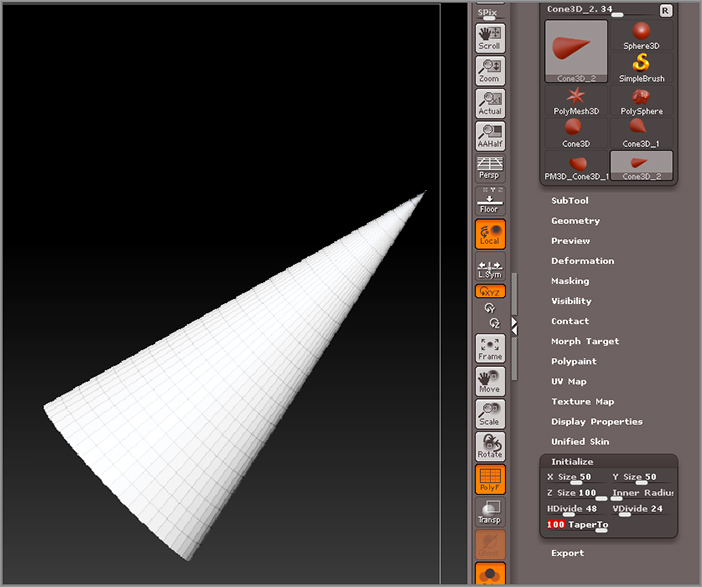
Now that the cone has been shaped parametrically, you can convert it into a sculptable mesh.
Figure 3-31: The Cone3D object is converted into a sculptable polymesh object by clicking the Make PolyMesh3Dbutton in the Tool palette.
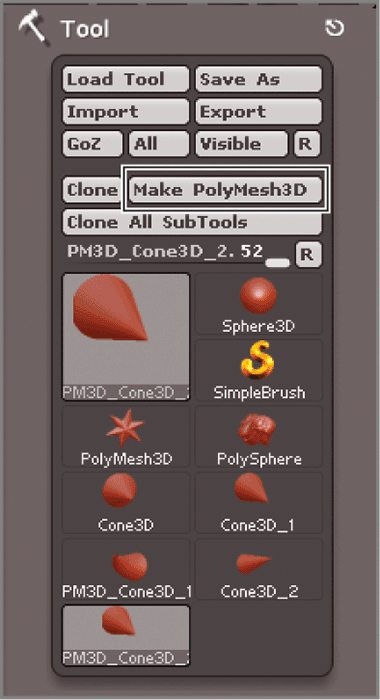
Figure 3-32: Once converted to a polymesh object, the cone can be sculpted with the sculpting brushes.

It’s important to understand that when you click the Make PolyMesh3D button, ZBrush actually creates a mesh copy of the parametric tool you’re working on. In fact, if you open up the sculpting library you’ll see two cones, one labeled Cone3D and the other labeled PM3D_Cone3D_1 (see Figure 3-33). Cone3D is the original cone and PM3D_Cone3D_1 is the mesh copy. This is actually very convenient because you can switch back to the original Cone3D object, make more changes with the sliders in the Initialize subpalette, and then make another copy with the Make PolyMesh3D button. Using this method you can quickly generate as many variations on the original cone as you like.
Figure 3-33: A polymesh copy of the parametric Cone3D tool is placed in the tool library when you click the Convert to PolyMesh3D button.

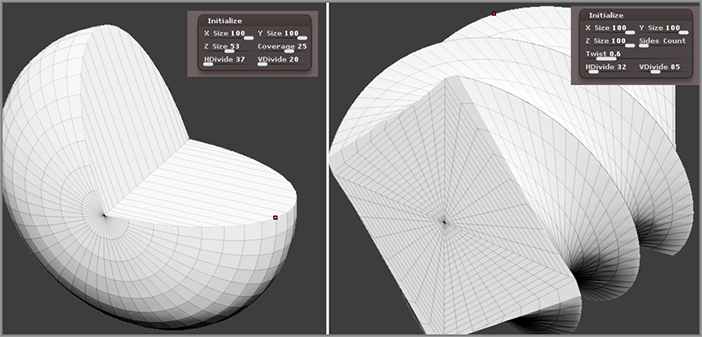
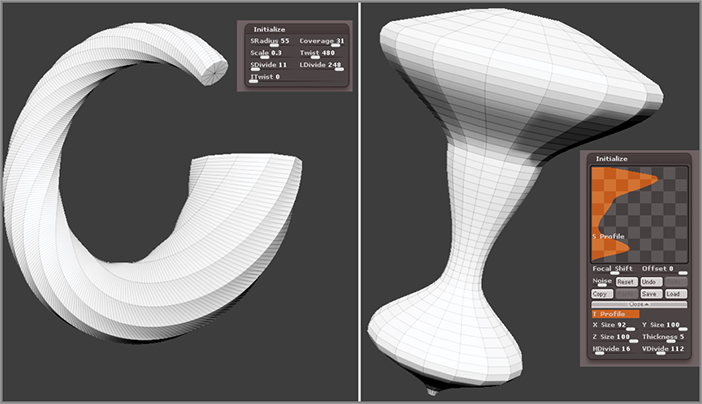
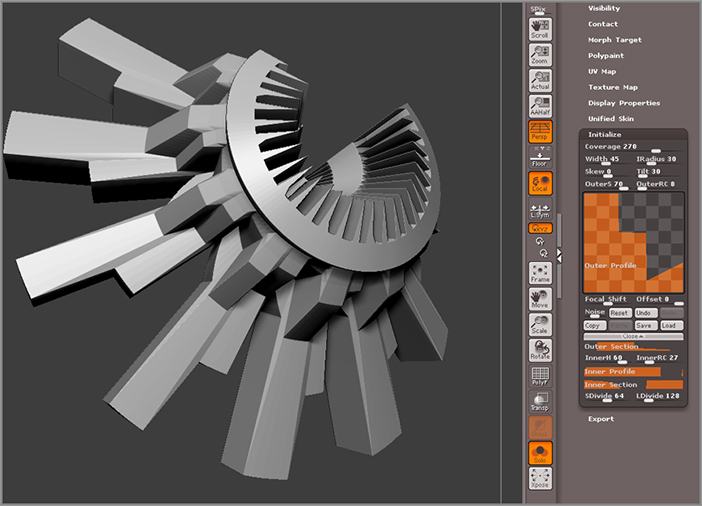
Figure 3-34: The deformers are a set of sliders found in the Deformation subpalette of the Tool palette.

Bending the Tooth Using Deformations
Now let’s put a slight bend in the tooth to make it more like a dragon’s tooth. To do this, we’ll use the Smooth Bend deformer in the Deformations subpalette of the Tool palette. The Deformation subpalette contains a large number of sliders, each of which can be used to deform your surface, allowing you to twist, mold, bend, and manipulate the overall shape of your object with numerical precision (see Figure 3-34).
Figure 3-35: Set the SBend axis to Y, and set the deformer value to 15.

Figure 3-36: The dragon’s tooth is created by applying the SBend deformer to the polymesh cone.
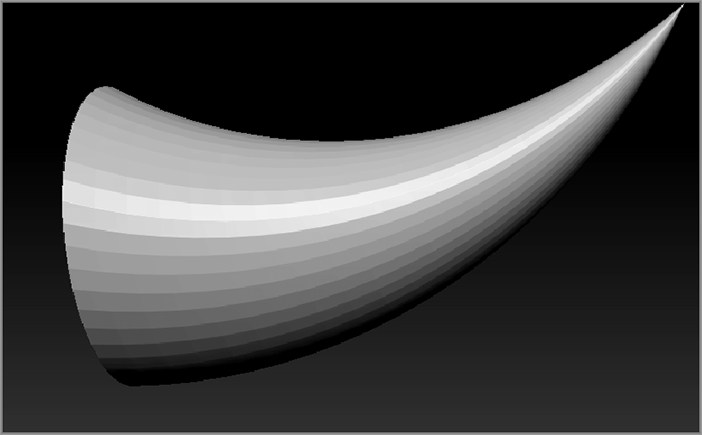
Using the Insert Brush to Add the Tooth to the Dragon
Now that you have a tooth modeled, it’s time to add it to the dragon. Just like with the eye, you’ll use an insert brush to accomplish this. The first step is to edit one of the existing brushes so that it will allow you to add the tooth created in the previous sections by simply dragging on the model.
Figure 3-37: Use the Modifiers subpalette of the Brush palette to select the tooth from the tool library.
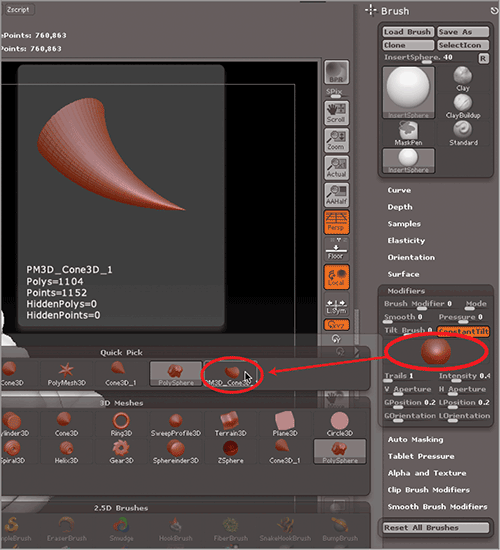
Figure 3-38: The icon for the InsertSphere brush changes automatically.

The tooth appears in the mouth, and as you drag it, the tooth continues to grow in size. If the dragon’s head disappears while you are dragging, don’t panic; once you let go, the head reappears.
Figure 3-39: The tooth is placed in the dragon’s mouth from above.
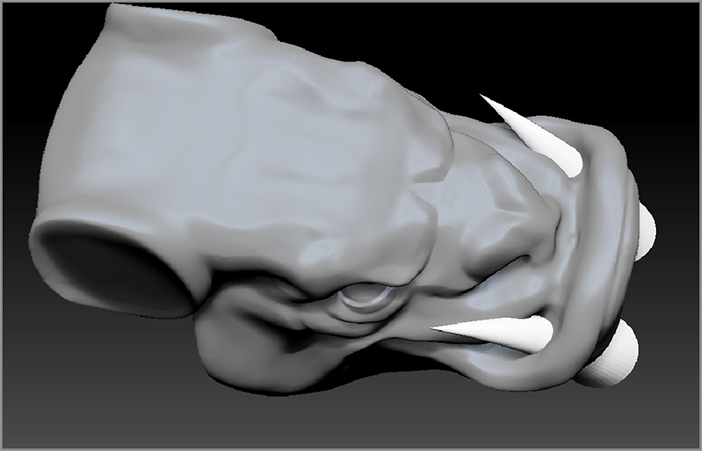
It’s highly unlikely that the placement of the tooth was exactly what you want. You can undo and try again, but you might find yourself going crazy trying to get it perfect using the InsertTooth brush alone. This is why the dragon’s head is instantly masked when you insert a mesh. It allows you to adjust the inserted mesh after you draw it into the object without affecting the original surface.
After you insert the mesh, you’ll need to perform a few more steps to get it positioned perfectly. The first time you do this it may feel a bit overwhelming, but it actually becomes very intuitive and fast with a little practice. In the next section you’ll learn how you can use the versatile Transpose brush to move, scale, and rotate the tooth.
Using the Transpose Brush to Position the Tooth
The Transpose brush is a special type of brush that lets you move, scale, and rotate your meshes. Generally it’s used in conjunction with masking as a way to pose figures or move individual parts of an object. In this section, you’ll learn the basics of using it as a way to position the tooth you’ve added to your dragon’s head.
The Transpose brush is activated when you click the Move, Scale, or Rotate button on the top shelf while a mesh is in Edit mode, or you can select the Transpose brush from the sculpting brush library. When you select this brush, the brush cursor changes into a line with three pairs of concentric circles (see Figure 3-40). One pair of circles is at the center, and the other two are at either end of the line. The line that connects the three pairs of circles is known as the action line, and it determines the central axis of the control.
Figure 3-40: The Transpose control looks like a line connecting three pairs of concentric circles.
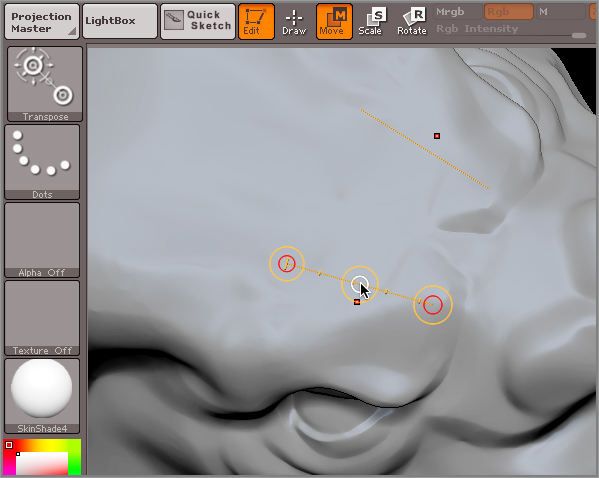
The three pairs of circles along the action line are the handles. The outside circle of each pair is used to position the control, and the inside circle of each pair is used to pose the mesh. It takes a little practice, but after some experimentation, you’ll find that using the control becomes easy. I like to think of the Transpose brush as a virtual wrench. Any part of the surface that is not masked can be pulled, scaled, or twisted as you move around the handles of the brush.
The following demonstrates how to use the Transpose control to position the tooth you inserted into the mouth in the previous section:
In the case of my dragon, the teeth are very large and stick out of the bottom of its jaw. I’m going to start by moving the teeth up, and then I will scale them down and finally rotate them. Since symmetry is activated, anything I do to one tooth will be mirrored to the tooth on the opposite side.
Figure 3-41: Draw the Transpose line from the bottom of the tooth to the space above the head (left image). Drag on the center circle to move the tooth into position (right image).

Keep the idea of a virtual wrench in mind; it’s a good way to visualize how Transpose works. Basically, each handle on the Transpose brush works in a different way.
- The outer circle of each handle lets you position Transpose in 3D space. Drag on the outer circles at the end of the handle to position the ends.
- The inner circle of each handle deforms the unmasked parts of the mesh based on the current mode (Move, Scale, or Rotate) of Transpose.
- The circle on the opposite side of the Transpose handle sets the pivot point from the deformation.
- The hotkeys for each mode of the brush are Move = W, Scale = E, and Rotate = R.
- More advanced Transpose techniques are discussed in Chapter 4.
Figure 3-42: The tooth is scaled and rotated using Transpose. Because symmetry is activated, changes on one tooth are mirrored to the tooth on the opposite side.
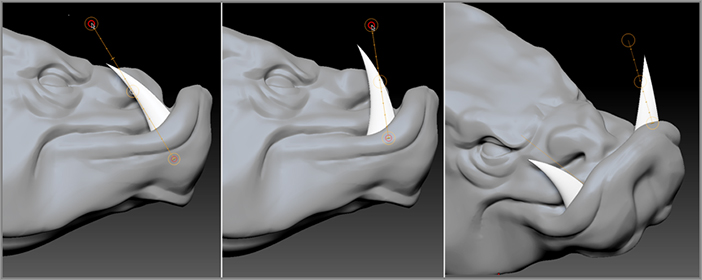
In the next section, you’ll learn a great trick for quickly duplicating the teeth. And you’ll finish the head of the dragon with some nice curling horns.
Duplicating the Teeth Using Transpose
In this section you’ll learn a cool trick for duplicating objects using the Transpose brush. Using this technique you’ll add a row of teeth to the dragon’s head you’ve been developing throughout this chapter.
Figure 3-43: The tooth is duplicated and moved toward the center using the Transpose brush (left image). The duplicate tooth and its mirror copy are scaled and rotated using the Transpose brush (right image).
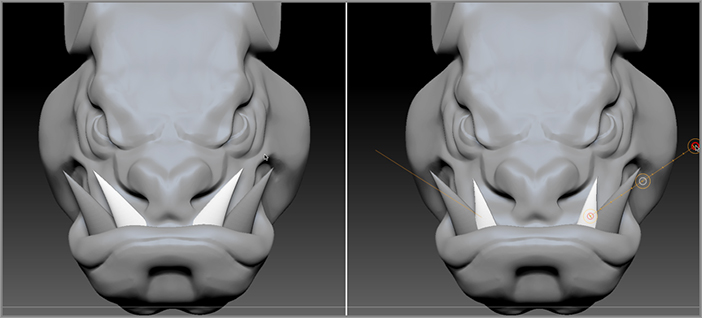
Figure 3-44: Multiple teeth are created by duplication with the Transpose brush. The teeth are scaled and rotated to create a gruesome array.
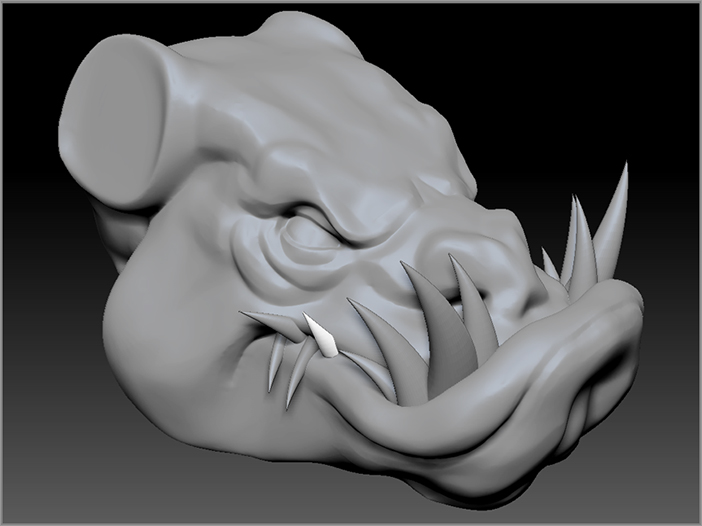
Adding Horns to the Dragon Head
You’ll notice that in my version of the dragon I have two round, flat areas on either side of the head. I created these with the intention of adding horns to the surface. To add horns, I used the same techniques as I demonstrated with the teeth. Instead of using the Cone parametric tool to make the horns, I used the Spiral3D tool. I created my own InsertHorn brush from a polymesh version of the Helix3D tool and then inserted into the mesh. I then used Transpose to align the horns on the head correctly. Figure 3-45 shows stages in the process. I recommend trying these techniques on your own model as a way to review the techniques described in this chapter. ZBrush gets much easier with practice. I highly recommend going through these steps.
Figure 3-45: Horns of the dragon are created using the Spiral3D tool and then inserted using a customized insert brush. Using the Transpose brush they are moved, scaled, and rotated to match the head.

It may take a while to get the horns aligned. Remember that you can invert the mask (Ctrl+I) and use the Move brush to make the flesh of the dragon head meet the end of the horns. Just make sure that you don’t clear the mask entirely!
Save the file when you are happy with the placement of the horns. Don’t worry about detail just yet. In the next chapter you’ll take this model even further as you learn about polygroups, subtools, and ZSpheres.
To see a version of the head that I created up to this point, open the dragonHead_v01.ZPR project from the Chapter 3 folder on the DVD that comes with this book. I also included my insertTooth.zbp brush and my insertHorn.zbp brush. You can load these brushes using the Load button in the Brush palette.
Summary
In this chapter you’ve taken your first steps into the world of digital sculpting with ZBrush. You’ve learned how to take a simple polymesh sphere and shape it into the form of a dragon’s head using the sculpting brushes. You’ve learned how to use Dynamesh to create a sculpting-friendly topology and how to add parts using parametric 3D objects and Transpose.
In Chapter 4, “Polymesh Editing,” you’ll learn how to organize the mesh using polygroups, how to create a simple multi-object hierarchy using subtools, and how to work with ZSpheres to create an armature for your model.
